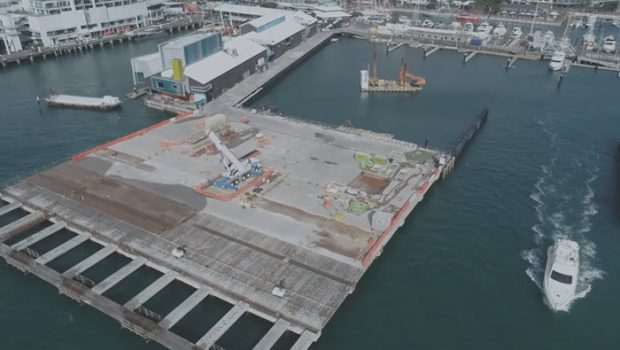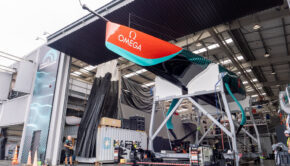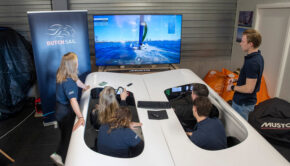America’s Cup: That was then, this is now
Published on August 3rd, 2019
In the modern era of the America’s Cup, which includes a centralized venue for teams and fans, the host city must proceed with a plan before the details of the competition are complete. Central to the situation is the number of teams – more teams means more space and cost but ideally more revenue.
It is a roll of the dice for the host city, and one where crapping out has been more the rule than the exception. It is not bait and switch, per se, but both 2013 in San Francisco and 2017 in Bermuda just weren’t as big as expected.
Now it’s Auckland’s turn to sort through the situation, as they had to pull the trigger on a plan before the entry deadline, and their plan was bigger than reality has proven. Once again, reality sucks.
As reported by the New Zealand Herald, the Auckland Council is looking at saving costs in the construction of the 2021 America’s Cup bases in Viaduct Marina because fewer challengers are coming.
Partners in the project are considering how they may use “repurposed” base space. Housing of emergency services for the event is a possibility.
Auckland Council and the Government put in $250 million to create seven team bases. But only five are needed after challengers Dutch Sail and Malta Altus pulled out due to financial strain over the difficulty in building the AC75 monohull-style yachts selected for the event.
The chair of the 36th America’s Cup advisory, Dean Kimpton told the Weekend Herald the original designs and budgets for the Viaduct Marina “transformation” were an overestimation of the current scale of the event.
“With the long lead time required for design and construction, decisions needed to be made based on the best information we had at the time,” Kimpton said.
When the scope was agreed with the Wynyard Edge Alliance the decision was made to proceed on the basis of six potential challengers.
Kimpton said all members of the Wynyard Edge Alliance, the construction conglomerate responsible for building the bases in Viaduct Marina, have been “committed to find cost savings where practicable” across the design and construction phase.
“With five teams – four challengers as well as the defender – we are looking at what cost saving options there are in light of the reduced base requirements, our existing contractual commitments, how the existing challenger bases could be re-purposed during the event and how the space will be used between defenses.
“This process is what ratepayers and taxpayers should expect to ensure their money is being spent wisely. Decisions on this are yet to be made.”
Auckland Council said possible cost saving amounts could be released in the coming weeks.
In an earlier interview with the Herald, Emirates Team NZ boss Grant Dalton said if he was to “pinpoint one thing I’m most happy about” it would be the look and speed of the Viaduct construction.
“The way (Wynyard Edge) Alliance has worked to hold deadlines, in fact even exceed deadlines, is remarkable,” Dalton said.
“You can’t fault it actually. People will try, but I certainly haven’t been able to and I watch it every day. Unbelievable.”
There is precedent for America’s Cup events being delivered under-budget – unlikely as it seems in the billionaire-backed world of high-performance competitive sailing.
A report from PricewaterhouseCoopers of the 2017 Bermuda event found it came in $64.1 million (USD) – $12.9 million under the original budget of $77m.
Such figures put pressure on the Auckland event already scrutinized for its tenuous cost/benefit ratio – determined in a commissioned report for the Ministry of Business in 2017 with a range from 0.997 to 1.14.
The NZ Initiative was responsible for correcting errors in the overly optimistic initial cost/benefit ratio of the 2017 Market Economics report, and their chief economist Eric Crampton said the financial outlook for the event has not improved in the last two years.
“Because a lot of investments have to be planned early, before the number of teams is entirely finalised, government and council can wind up taking on a lot of risk in exchange for effectively no return on investment. It is hard to downsize those fixed investments in response to a smaller than expected event,” Crampton told the Herald this week.
“Central and local government committed to covering costs for an America’s Cup event despite an MBIE assessment that expected benefits were only barely on par with costs.”
The two “repurposed” unused bases, will be within a row of structures along the east side of Wynyard Wharf, along with three bases being used by the two US challengers, American Magic and Stars + Stripes, and UK team Ineos.
A separate base has been constructed for the Italian Prada team on a $37 million extension of Hobson Wharf – despite now able to move into one of the vacant bases on Wynyard Wharf.
Team NZ’s base did not have to be built, as it is a renovation of the Viaduct Events Centre. However, the fit out of the team’s base will still cost millions of dollars.
The other four challengers fit-out their own team bases at their own cost.
Construction for Team NZ’s base was completed in June.
In addition to Challenges from Italy, USA, and Great Britain that were accepted during the initial entry period (January 1 to June 30, 2018), eight additional Notices of Challenge were received by the late entry deadline on November 30, 2018. Of those eight submittals, entries from Malta, USA, and the Netherlands were also accepted. Here’s the list:
Defender:
• Emirates Team New Zealand (NZL)
Challengers:
• Luna Rossa (ITA) – Challenger of Record
• American Magic (USA)
• INEOS Team UK (GBR)
• Malta Altus Challenge (MLT) – WITHDRAW
• Stars & Stripes Team USA (USA)
• DutchSail (NED) – WITHDRAW
Of the three late entries, only Stars+Stripes USA remains committed, but they still must complete the entry fee payment process before they will be eligible to race. They have already paid their initial payment but as a late entry challenger under the Protocol they also have a liability to pay a US$1million late entry fee due in installments by October 1, 2019. This deadline coincides with the venue schedule which has the construction of their team base beginning in late 2019, which we assume was done in the event the team is unable to fulfill their payment deadline.
Key America’s Cup dates:
✔ September 28, 2017: 36th America’s Cup Protocol released
✔ November 30, 2017: AC75 Class concepts released to key stakeholders
✔ January 1, 2018: Entries for Challengers open
✔ March 31, 2018: AC75 Class Rule published
✔ June 30, 2018: Entries for Challengers close
✔ August 31, 2018: Location of the America’s Cup Match and The PRADA Cup confirmed
✔ August 31, 2018: Specific race course area confirmed
✔ November 30, 2018: Late entries deadline
✔ March 31, 2019: Boat 1 can be launched (DELAYED)
✔ 2nd half of 2019: 2 x America’s Cup World Series events (CANCELLED)
October 1, 2019: US$1million late entry fee deadline
February 1, 2020: Boat 2 can be launched
April 23-26, 2020: First America’s Cup World Series event in Cagliari, Sardinia.
During 2020: 3 x America’s Cup World Series events
December 10-20, 2020: America’s Cup Christmas Race
January and February 2021: The PRADA Cup Challenger Selection Series
March 2021: The America’s Cup Match
Details: www.americascup.com









 We’ll keep your information safe.
We’ll keep your information safe.